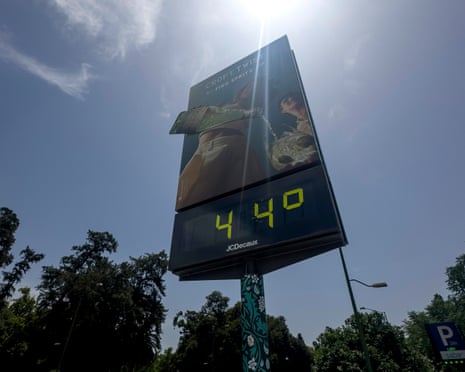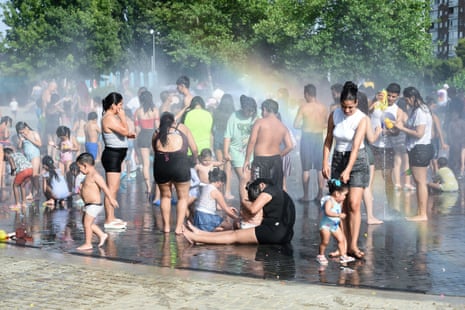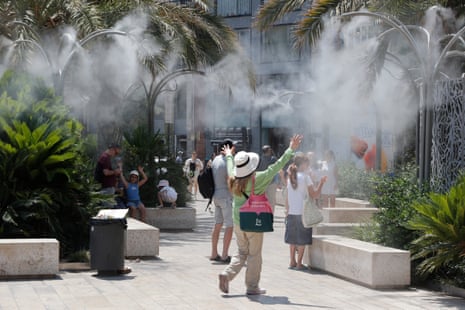Spain on high heat alert after provisional June temperature record of 46C
Sam Jones
in Madrid
Spain remains on high heat alert – especially after a provisional June temperature record of 46C (114.8F) was set on Saturday afternoon in El Granado in the Andalucían province of Huelva. The highest temperature previously recorded for June was the 45.2C logged in Seville in 1965.

The heatwave, which is forecast to last until Thursday, could see temperatures in parts of the country reach 42C on Monday.
Spain’s state meteorological office, Aemet, and its health ministry have warned people to take extra care in the heat.
“We are expecting abnormally high and persistent temperatures, during both day and night, that could pose a risk to vulnerable or exposed people,” Aemet said in a statement on Saturday.
The health ministry, meanwhile, has urged people to monitor weather alerts, to stay hydrated and out of the sun, and to check on those who may be at risk.
“Remember that while the heat affects us all, it affects different people in different ways,” it said.
“Take special care if you have a risk factor – these categories include: people aged over 65 and under four; pregnant women; people with chronic illnesses, and those in situations of loneliness or socioeconomic vulnerability.”
Spain recorded its highest ever temperature in August 2021, when the mercury in the Andalucían town of Montoro, near Córdoba, reached 47.4C.
A 2022 Aemet study found that the arrival of 30C temperatures across Spain and the Balearic islands had come an average of 20 to 40 days earlier over the past 71 years. “The summer is eating up the spring,” Aemet’s spokesperson Rubén del Campo told El País at the time.
“What’s happening fits perfectly with a situation where you have a warmer planet,” he said, adding that the rise in temperatures was a “direct and palpable [consequence] of climate change … The climate in Spain isn’t the one we used to know. It’s got more extreme.”
Key events Show key events only Please turn on JavaScript to use this feature
Almost entire mainland France on 'unprecedented' heat alert

Angelique Chrisafis
in Paris
In France — where heatwave alerts often centre on specific areas — for the first time in history, almost the entire mainland France was on alert.

“This is unprecedented,” said Agnes Pannier-Runacher, France’s ecology transition minister as a record 84 of the nation’s 96 mainland departments were placed on the second-highest “orange” heat alert.
Only a small sliver of the northern coast in Brittany and part of Normandy were not placed on alert.
In some areas, temperatures were expected to exceed 40 degrees on Monday and Tuesday, also creating drought warnings in 25 areas.
The government asked businesses to adapt staff hours to protect workers from the heat. A total of 200 public schools across France were to be partially or totally closed on Monday and Tuesday.
On the A86 motorway outside Paris, road speed limits were placed at 20km an hour to reduce pollution.
Firefighters were also on alert.
The first major fire of the summer broke out in the Corbières areas of Aude in the south-west at the weekend, believed to have been caused by a barbecue being transported in a trailer behind a car which had not been completely put out and still contained hot ash.
Some 400 hectares burned and more than 100 people were evacuated from the area as a precaution. The fire was under control on Monday morning.
Your experiences of European heatwave

Jakub Krupa
Thanks for your first submissions on your experience of the European heatwave and how you’re dealing with it.

Rafael sends his greetings from Barcelona’s hottest neighbourhood, as he says:
“Due to the heat island effect, Barcelona is usually hotter than the surrounding countryside. But temperatures also vary within the city: the neighbourhoods situated at higher elevations are usually a bit cooler, while the old city, nearly at sea level, is usually hottest.
We are dealing with the heat by staying indoors, and by using fans and air conditioners. Because it’s next to the sea, Barcelona has high humidity, which makes the heat even more unbearable.”
Elaine shared a picture from her friend in Seville, showing 48 Celcius on a street thermometer. “You get the idea!”
Linda tells me about the preparations in the Netherlands, where the heatwave is expected to hit tomorrow.
“It’s expected to reach up to 38 degrees tomorrow. A heat warning is in place. Our children’s school is sending them home at 12pm tomorrow.”
Joanna is loving the heatwave, though:
“Have the enormous luck to be on a sailing boat in northern Sardinia at the moment. Can’t beat a sea breeze to keep the heat at bay.”
As is John, who is holidaying in Provence, France, and has this, unusual, way of dealing with the heat:
We’re coping by lazing by the pool … and Kevin, our friend from Dundee has a unique Scottish solution to coping with the heat, stand on your head for 10 minutes in the sun before jumping into a cold pool followed by a piping hot cup of tea!
Erm, what!?
Email me with your stories on jakub.krupa@theguardian.com.
What is the role of human-caused climate breakdown in causing heatwaves?
Human-caused climate breakdown is supercharging extreme weather across the world, driving more frequent and more deadly disasters from heatwaves to floods to wildfires. At least a dozen of the most serious events of the last decade would have been all but impossible without human-caused global heating.
Human-caused climate breakdown is making every heatwave in the world more intense and more likely to happen. Some, such as the extreme heatwave in western Canada and the US in 2021, would have been all but impossible without global heating.
And when it comes to the current heatwave, the Climate Shift Index, which shows if the weather anomaly is linked to climate change, is very much indicating just that for Spain, France and Italy at the moment, giving it the highest rating of plus five.
Your experiences of European heatwave - let me know

Jakub Krupa
Eoin writes in to say:
Thanks for covering the heatwave. Spare a thought for those of us walking the Portuguese Camino de Santiag[o] - it was 42 (“feels like 44”) in Santarem last night.
The temperature is expected to hit a nice and breezy 41C today in Santarem in early afternoon today. Stay safe, Eoin!
If you are in the countries most affected by the heatwave, email me about your experiences – and how you’re dealing with it – at jakub.krupa@theguardian.com.
Spain on high heat alert after provisional June temperature record of 46C
Sam Jones
in Madrid
Spain remains on high heat alert – especially after a provisional June temperature record of 46C (114.8F) was set on Saturday afternoon in El Granado in the Andalucían province of Huelva. The highest temperature previously recorded for June was the 45.2C logged in Seville in 1965.

The heatwave, which is forecast to last until Thursday, could see temperatures in parts of the country reach 42C on Monday.
Spain’s state meteorological office, Aemet, and its health ministry have warned people to take extra care in the heat.
“We are expecting abnormally high and persistent temperatures, during both day and night, that could pose a risk to vulnerable or exposed people,” Aemet said in a statement on Saturday.
The health ministry, meanwhile, has urged people to monitor weather alerts, to stay hydrated and out of the sun, and to check on those who may be at risk.
“Remember that while the heat affects us all, it affects different people in different ways,” it said.
“Take special care if you have a risk factor – these categories include: people aged over 65 and under four; pregnant women; people with chronic illnesses, and those in situations of loneliness or socioeconomic vulnerability.”
Spain recorded its highest ever temperature in August 2021, when the mercury in the Andalucían town of Montoro, near Córdoba, reached 47.4C.
A 2022 Aemet study found that the arrival of 30C temperatures across Spain and the Balearic islands had come an average of 20 to 40 days earlier over the past 71 years. “The summer is eating up the spring,” Aemet’s spokesperson Rubén del Campo told El País at the time.
“What’s happening fits perfectly with a situation where you have a warmer planet,” he said, adding that the rise in temperatures was a “direct and palpable [consequence] of climate change … The climate in Spain isn’t the one we used to know. It’s got more extreme.”
The ‘silent killer’: what you need to know about heatwaves

Ajit Niranjan
Heatwaves have grown hotter and stronger as the planet has warmed, making what doctors call a “silent killer” even more dangerous.

How worried should we be about heat – and how can we stay safe as the climate changes?
Hot weather kills an estimated half a million people each year. The average annual death toll is greater than that from wars or terrorism, but smaller than that from cars or air pollution.
High heat stresses the human body. When days are too hot to function and nights are not cool enough to recover, the heart and kidneys go into overdrive working to keep the body cool.
There are also secondary health effects from high heat. Heatwaves lead to more accidents, dirtier air, bigger wildfires and more frequent blackouts, all of which can increase the burden on health systems.
People who are forced to be outdoors in scorching weather – builders, farmers, rough sleepers – are most likely to suffer from heat exhaustion and the heatstroke that can follow.
But older people, and particularly those with underlying illnesses, make up the bulk of heat-related deaths. Women are more likely to die from heat-related causes than men. Poorer people – who are less likely to have air conditioning, well-insulated homes, or access to green spaces – are also at greater risk.
The simplest advice is to stay out of the heat: avoid going outside during the hottest parts of the day, and stay in the shade if you have to. To keep your home cool, close windows during the day and open them after dark, when outdoor temperatures fall below inside temperatures. Cover windows with blinds or curtains to block out direct sunlight.
Doctors also recommend drinking water frequently, wearing loose clothing and checking on vulnerable people in your community.
European heatwave - in pictures



Morning opening: It's hot out there

Jakub Krupa
Large parts of Europe continue to be gripped by a heatwave today, with temperatures in mid to high 30s and low 40s Celsius and a range of health and environmental alerts issued across the continent, particularly its southern part.

France, Italy, Portugal and Spain, in particular, have seen extreme weathers over the weekend and they are likely to continue today.
Just take a quick look at the weather forecast: Rome, Madrid and Bologna (36C), Athens and Naples (35C), Lisbon (34C), Zagreb (33C), Paris (32C), London (31C).
There are pockets where the temperatures are even going to hit low 40s, such as in the Extremadura region of Spain.
In Italy, 27 cities were on high alert for extreme health on Sunday. In France, 84 of the nation’s 96 mainland departments are on the second-highest “orange” heat alert, AFP reported.
“This is unprecedented,” Agner Pannier-Runacher, France’s ecology transition minister said.
I will bring you all the latest updates from across Europe here.
It’s Monday, 30 June 2025, it’s Jakub Krupa here, and this is Europe Live.
Good morning.

 5 hours ago
5 hours ago

















